Utilizing the Fusion Characteristics of Multispectral and Electronic Noses to Detect Soil Main Nutrient Content
Abstract
:1. Introduction
2. Materials and Methods
2.1. Soil Sample Collection
2.2. Electronic Nose Response
2.3. Multi-Spectral Image Acquisition
2.4. Feature Optimization Algorithms
2.5. The Regression Prediction Model
3. Results and Discussion
3.1. Data Downscaling and Selection
3.2. Modeling Results of Different Regression Models
3.3. Comparison of Soil Nutrient Detection Methods
4. Conclusions
- (1)
- The correlation heatmap between spectral index features and SOM, TN, AK, and AP showed a certain degree of correlation between spectral indices and soil nutrients, with each feature exhibiting varying degrees of correlation with different nutrients. This indicates that spectral indices can effectively utilize multispectral images of soil.
- (2)
- The modeling results indicate that the utilization of multispectral technology can assist electronic nose techniques in achieving higher precision prediction of soil nutrient content. Compared with other studies, whether employing single electronic nose methods or conventional detection techniques, the performance of the multi-source feature fusion method proposed in this study demonstrates superiority. Additionally, it significantly reduces the prediction cost of soil nutrient content, paving the way for new avenues in subsequent research on soil nutrient detection.
- (3)
- Compared to existing methods that primarily focus on predicting SOM content, this study also achieved the prediction of two nutrients (AK and AP) that, although they represent a small proportion of soil nutrients, are nevertheless important. This lays the theoretical foundation for multi-nutrient detection methods in soil. Although the prediction accuracy of AK and AP in this study meets the requirements of general agriculture, further research is needed to develop higher-precision detection methods to enhance the prediction accuracy of AK and AP content, aiming for precision and intelligent agricultural practices.
Author Contributions
Funding
Institutional Review Board Statement
Data Availability Statement
Conflicts of Interest
References
- Beltrame, K.K.; Souza, A.M.; Coelho, M.R.; Winkler, T.C.B.; Souza, W.E.; Valderrama, P. Soil Organic Carbon Determination Using NIRS: Evaluation of Dichromate Oxidation and Dry Combustion Analysis as Reference Methods in Multivariate Calibration. J. Braz. Chem. Soc. 2016, 27, 1527–1532. [Google Scholar] [CrossRef]
- Zhao, L.; Liu, X.; Wang, Y.; Ren, T. Thermal analysis determining soil organic matter content and thermal stability. Trans. Chin. Soc. Agric. Eng. 2016, 32, 105–114. [Google Scholar]
- Traoré, S.; Thiombiano, L.; Millogo, J.R.; Guinko, S. Carbon and nitrogen enhancement in Cambisols and Vertisols by Acacia spp. in eastern Burkina Faso: Relation to soil respiration and microbial biomass. Appl. Soil Ecol. 2007, 35, 660–669. [Google Scholar] [CrossRef]
- Abril, A.; Noe, L.; Casado-Murillo, N.; Kopp, S. Non-Symbiotic N2 Fixation in Soil, Litter and Phyllosphere in the Arid-Semiarid Region of Central Argentina; Nova Science Publishers, Inc.: Hauppauge, NY, USA, 2008. [Google Scholar]
- Xin, J.; Zheng, L.; Zhong, H.; Huang, Y.; Lv, Y.; Wang, X. Soil Testing Part 7: Determination of Available Phosphorus in Soil: NY/T 1121.7-2014; Ministry of Agriculture of the People’s Republic of China: Beijing, China, 2014. [Google Scholar]
- Ren, Y. Comparison of two detection methods for determining available phosphorus in weakly acidic soil. Shanxi Chem. Ind. 2023, 43, 79–80+93. [Google Scholar]
- Gong, N.; Deng, F.; Li, G.; Pan, S. Analysis of Soil Fertilizer Testing Technology. China Pet. Chem. Stand. Qual. 2017, 37, 29–30. [Google Scholar]
- He, X.; Yang, L.; Li, A.; Zang, L.; Shen, F.; Cai, Y.; Zhou, C. Soil organic carbon prediction using phenological parameters and remote sensing variables generated from Sentinel-2 images. Catena 2021, 205, 105442. [Google Scholar] [CrossRef]
- Sorenson, P.T.; Kiss, J.; Bedard-Haughn, A.K.; Shirtliffe, S. Multi-Horizon Predictive Soil Mapping of Historical Soil Properties Using Remote Sensing Imagery. Remote Sens. 2022, 14, 5803. [Google Scholar] [CrossRef]
- Gholizadeh, A.; Žižala, D.; Saberioon, M.; Borůvka, L. Soil organic carbon and texture retrieving and mapping using proximal, airborne and Sentinel-2 spectral imaging. Remote Sens. Environ. 2018, 218, 89–103. [Google Scholar] [CrossRef]
- Boyan, K.; Yucel, T.; Abdul, M.M. Comparison between artificial neural network and partial least squares for on-line visible and near infrared spectroscopy measurement of soil organic carbon, pH and clay content. Soil Tillage Res. 2015, 146, 243–252. [Google Scholar]
- Sithole, N.J.; Khayelihle, N.; Magwaza, L.S. Robust Vis-NIRS models for rapid assessment of soil organic carbon and nitrogen in Feralsols Haplic soils from different tillage management practices. Comput. Electron. Agric. 2018, 153, 295–301. [Google Scholar] [CrossRef]
- Tümsavaş, Z.; Tekin, Y.; Ulusoy, Y.; Mouazen, A.M. Prediction and mapping of soil clay and sand contents using visible and near-infrared spectroscopy. Biosyst. Eng. 2019, 177, 90–100. [Google Scholar] [CrossRef]
- Levi, N.; Karnieli, A.; Paz-Kagan, T. Using reflectance spectroscopy for detecting land-use effects on soil quality in drylands. Soil Tillage Res. 2020, 199, 104571. [Google Scholar] [CrossRef]
- Tang, H.; Meng, X.; Su, X.; Ma, T.; Liu, H.; Bao, Y. Hyperspectral prediction of organic matter in different types of soil based on CARS algorithm. J. Agric. Eng. 2021, 37, 105–113. [Google Scholar]
- Zhang, X.; Meng, X.; Tang, H.; Liu, H.; Zhang, X.; Liu, Q. A stochastic forest prediction model for soil organic matter with optimized spectral input. J. Agric. Eng. 2023, 39, 90–99. [Google Scholar]
- Vijayarangan, S.; Wettergreen, D. Assisting Spectral Mapping Using Cameras. In Proceedings of the 2023 IEEE/RSJ International Conference on Intelligent Robots and Systems (IROS), Detroit, MI, USA, 1–5 October 2023; pp. 10723–10728. [Google Scholar]
- Logie, G.S.J.; Coburn, C.A. An investigation of the spectral and radiometric characteristics of low-cost digital cameras for use in UAV remote sensing. Int. J. Remote Sens. 2018, 39, 4891–4909. [Google Scholar] [CrossRef]
- Bousefsaf, F.; Tamaazousti, M.; Said, S.H.; Michel, R. Image completion using multispectral imaging. IET Image Process. 2018, 12, 1164–1174. [Google Scholar] [CrossRef]
- Tan, L.; Feng, Z.; Zheng, H.; Yao, Z.; Weng, X.; Wang, F.; Chang, Z. Development Trend of Electronic Nose Technology in Closed Cabins Gas Detection: A Review. Appl. Sci. 2022, 12, 9326. [Google Scholar] [CrossRef]
- Zhu, L.; Jia, H.; Chen, Y.; Wang, Q.; Li, M.; Huang, D.; Bai, Y. A Novel Method for Soil Organic Matter Determination by Using an Artificial Olfactory System. Sensors 2019, 19, 3417. [Google Scholar] [CrossRef]
- Zhu, L.; Li, M.; Xia, X.; Huang, D.; Jia, H. Research on soil organic matter detection method based on artificial olfactory system. J. Agric. Mach. 2020, 51, 171–179. [Google Scholar]
- Zhu, L. Research on Soil Organic Matter Content Determination Method Based on Artificial Olfactory Technology. Ph.D. Thesis, Jilin University, Changchun, China, 2020. [Google Scholar]
- Li, M.; Zhu, Q.; Xia, X.; Liu, H.; Huang, D. Soil organic matter content detection method based on multi-sensor artificial olfactory system. J. Agric. Mach. 2021, 52, 109–119. [Google Scholar]
- Li, M. Research on Soil Organic Matter and Total Nitrogen Detection Methods Based on Thermal Decomposition and Artificial Olfaction. Ph.D. Thesis, Jilin University, Changchun, China, 2023. [Google Scholar]
- Vancampenhout, K.; De Vos, B.; Wouters, K.; Van Calster, H.; Swennen, R.; Buurman, P.; Deckers, J. Determinants of soil organic matter chemistry in maritime temperate forest ecosystems. Soil Biol. Biochem. 2010, 42, 220–233. [Google Scholar] [CrossRef]
- Ma, S.; Deji, Y.; Qin, X.; Chen, Y.; Hu, Y.; Wang, Z.; Lu, X. Chemical study of soil organic matter based on pyrolysis gas chromatography-mass spectrometry (Py-GC/MS) technology. J. Zhejiang AF Univ. 2021, 38, 985–999. [Google Scholar]
- Wang, X.; Deng, S.; Tan, H.; Adeosun, A.; Vujanović, M.; Yang, F.; Duić, N. Synergetic effect of sewage sludge and biomass co-pyrolysis: A combined study in thermogravimetric analyzer and a fixed bed reactor. Energy Convers. Manag. 2016, 118, 399–405. [Google Scholar] [CrossRef]
- Schulten, H.R.; Sorge, C.; Schnitzer, M. Structural studies on soil nitrogen by Curie-point pyrolysis—Gas chromatography/mass spectrometry with nitrogen-selective detection. Biol. Fertil. Soils 1995, 20, 174–184. [Google Scholar] [CrossRef]
- Ji, W.; Shi, Z.; Zhou, Q.; Zhou, L. Visible and Near-Infrared (VIS-NIR) Spectral Characteristics of Different Types of Soils and Organic Matter Response Bands. J. Infrared Millim. Waves 2012, 31, 277–282. [Google Scholar] [CrossRef]
- Fan, P.; Chu, D.; Wang, H.; Li, Y.; Liu, Y. Visible-Near Infrared Reflectance Spectral Characteristics of Soil Phosphorus Fractions and Their Spectral Analysis. Spectrosc. Spectr. Anal. 2023, 43, 73–74. [Google Scholar]
- Zhao, J.; Shi, Y.; Tan, Z.; Pan, B.; Huang, X.; Tang, J. Study on Hyperspectral Inversion Model of Available Potassium Content in Red Soil of Eucalyptus Plantation in Northern Guangxi. Anhui Agric. Sci. 2021, 49, 154–156+192. [Google Scholar]
- Lu, Y.; Bai, Y.; Wang, L.; Wang, H.; Yang, L. Hyperspectral Prediction Analysis of Total Nitrogen Content in Black Soil. Trans. Chin. Soc. Agric. Eng. 2010, 26, 256–261. [Google Scholar]
- Biney, J.K.M.; Saberioon, M.; Borůvka, L.; Houška, J.; Vašát, R.; Agyeman, P.C.; Coblinski, J.A.; Klement, A. Exploring the suitability of USA-based multispectral images for estimating soil organic carbon: Comparison with proximal soil sensing and spaceborne imagery. Remote Sens. 2021, 13, 308. [Google Scholar] [CrossRef]
- Heil, J.; Jörges, C.; Stumpe, B. Fine-scale mapping of soil organic matter in agricultural soils using UAVs and machine learning. Remote Sens. 2022, 14, 3349. [Google Scholar] [CrossRef]
- Xu, D. Research on Rapid Acquisition and Management Zoning of Farmland Soil Information Based on Multi-Source Information Fusion of Satellite and Ground. Ph.D. Thesis, Zhejiang University, Hangzhou, China, 2021. [Google Scholar]
- Rouse, J.W.; Haas, J.R.H.; Schell, J.A.; Deering, D.W. Monitoring vegetation systems in the Great Plains witherts. In Proceedings of the 3rd ERTS Symposium, Washington, DC, USA, 10–14 December 1974. [Google Scholar]
- Huete, A.; Didan, K.; Miura, T.; Rodriguez, E.P.; Gao, X.; Ferreira, L.G. Overview of the radiometric and biophysical performance of the MODIS. Remote Sens. Environ. 2002, 83, 195–213. [Google Scholar] [CrossRef]
- Gitelson, A.; Merzlyak, M.N. Spectral reflectance changes associated with autumn senescence of Aesculus hippocastanum L. and Acer platanoides L. leaves Spectral features and relation to chlorophyll estimation. J. Plant Physiol. 1994, 143, 286–292. [Google Scholar] [CrossRef]
- Jordan, C.F. Derivation of leaf-area index from quality of light on forest floor. Ecology 1969, 50, 663–666. [Google Scholar] [CrossRef]
- Qi, J.; Chehbouni, A.; Huete, A.R.; Kerr, Y.H.; Sorooshian, S. A modified soil adjusted vegetation index. Remote Sens. Environ. 1994, 48, 119–126. [Google Scholar] [CrossRef]
- Nellis, M.D.; Briggs, J.M. Transformed vegetation index for measuring spatial variation in drought impactedbiomass on Konza Prairie, Kansas. Trans. Kans. Acad. Sci. 1992, 95, 93–99. [Google Scholar] [CrossRef]
- Escadafal, R. Remote sensing of arid soil surface color with Landsat Thematic Mapper. Adv. Space Res. 1989, 9, 159–163. [Google Scholar] [CrossRef]
- Wang, S.; Guan, K.; Zhang, C.; Zhang, C.; Lee, D.; Margenot, A.J.; Ge, Y.; Peng, J.; Zhou, W.; Zhou, Q.; et al. Using soil library hyperspectral reflectance and machine learning to predict soil organic carbon: Assessing potential of airborne and spaceborne optical soil sensing. Remote Sens. Environ. 2022, 271, 112914. [Google Scholar] [CrossRef]
- Mruthyunjaya, P.; Shetty, A.; Umesh, P.; Gomez, C. Impact of atmospheric correction methods parametrization on soil organic carbon estimation based on hyperion hyperspectral data. Remote Sens. 2022, 14, 5117. [Google Scholar] [CrossRef]
- Xia, X.; Li, M.; Liu, H.; Zhu, Q.; Huang, D. Soil Organic Matter Detection Based on Pyrolysis and Electronic Nose Combined with Multi-Feature Data Fusion Optimization. Agriculture 2022, 12, 1540. [Google Scholar] [CrossRef]
- Li, M.; Xia, X.; Zhu, Q.; Liu, H.; Huang, D.; Wang, G. Soil total nitrogen detection method and feature optimization based on thermal decomposition and electronic nose. J. Agric. Eng. 2021, 37, 73–84. [Google Scholar]
- Liu, H. Design and Optimization of a Soil Major Nutrient Detection System BASED on Thermal Decomposition and Olfactory Information. Ph.D. Thesis, Jilin University, Changchun, China, 2023. [Google Scholar]
- He, S.; Tan, S.; Shen, L.; Zhou, Q. Soil Organic Matter Estimation Model Integrating Spectral and Profile Features. Sensors 2023, 23, 9868. [Google Scholar] [CrossRef] [PubMed]
- Wang, W.; Zhang, Y.; Li, Z.; Liu, Q.; Feng, W.; Chen, Y.; Jiang, H.; Liang, H.; Chang, N. Fourier-Transform Infrared Spectral Inversion of Soil Available Potassium Content Based on Different Dimensionality Reduction Algorithms. Agronomy 2023, 13, 617. [Google Scholar] [CrossRef]
- Zhou, T.; Geng, Y.; Chen, J.; Sun, C.; Haase, D.; Lausch, A. Mapping of Soil Total Nitrogen Content in the Middle Reaches of the Heihe River Basin in China Using Multi-Source Remote Sensing-Derived Variables. Remote Sens. 2019, 11, 2934. [Google Scholar] [CrossRef]
- Gasmi, A.; Gomez, C.; Chehbouni, A.; Dhiba, D.; Gharous, M.E. Using PRISMA hyperspectral satellite imagery and GIS approaches for soil fertility mapping (FertiMap) in northern Morocco. Remote Sens. 2022, 14, 4080. [Google Scholar] [CrossRef]


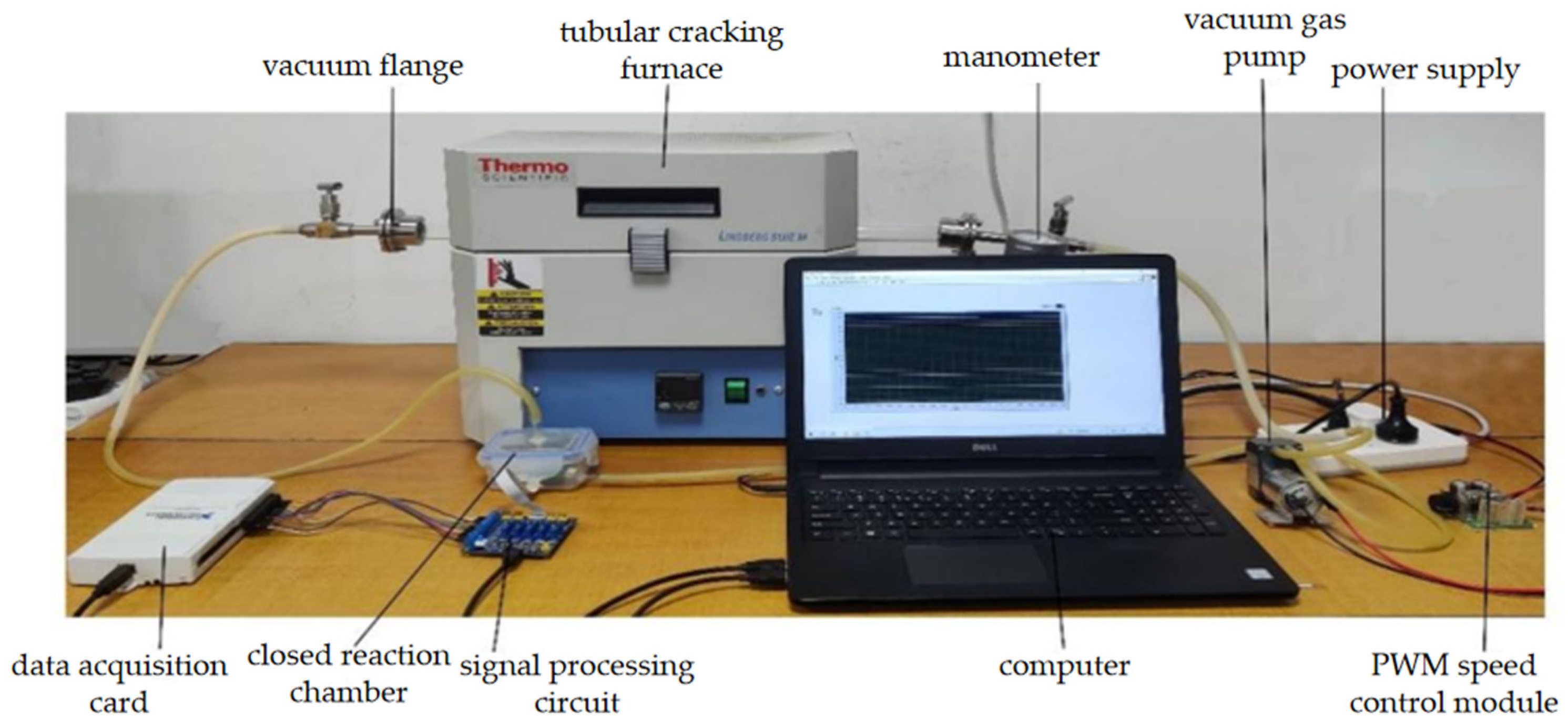
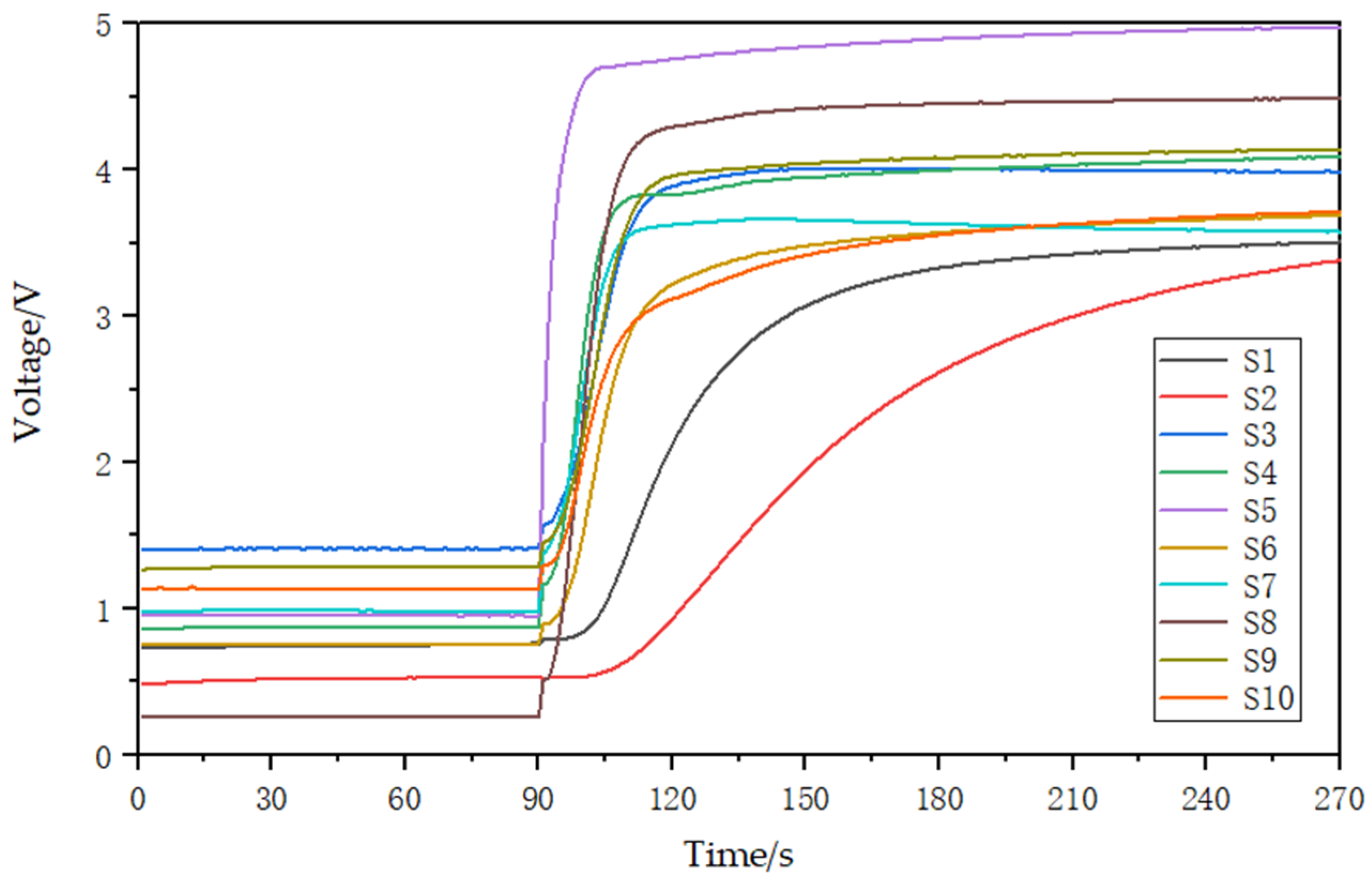
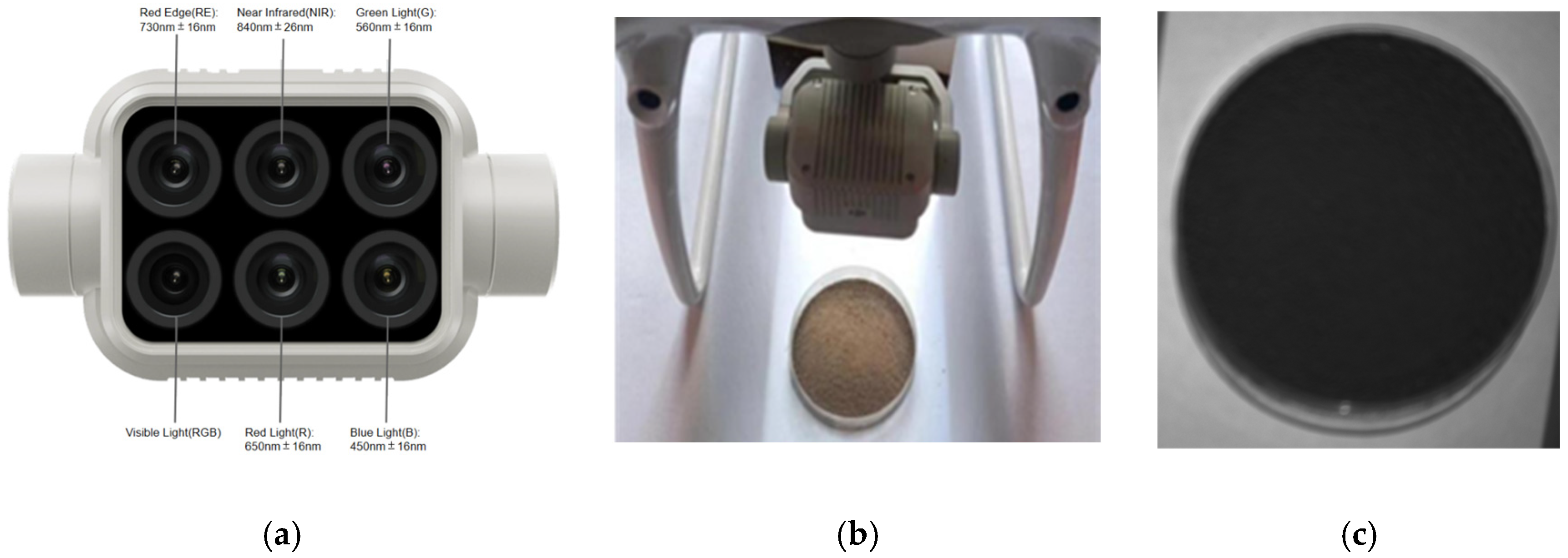

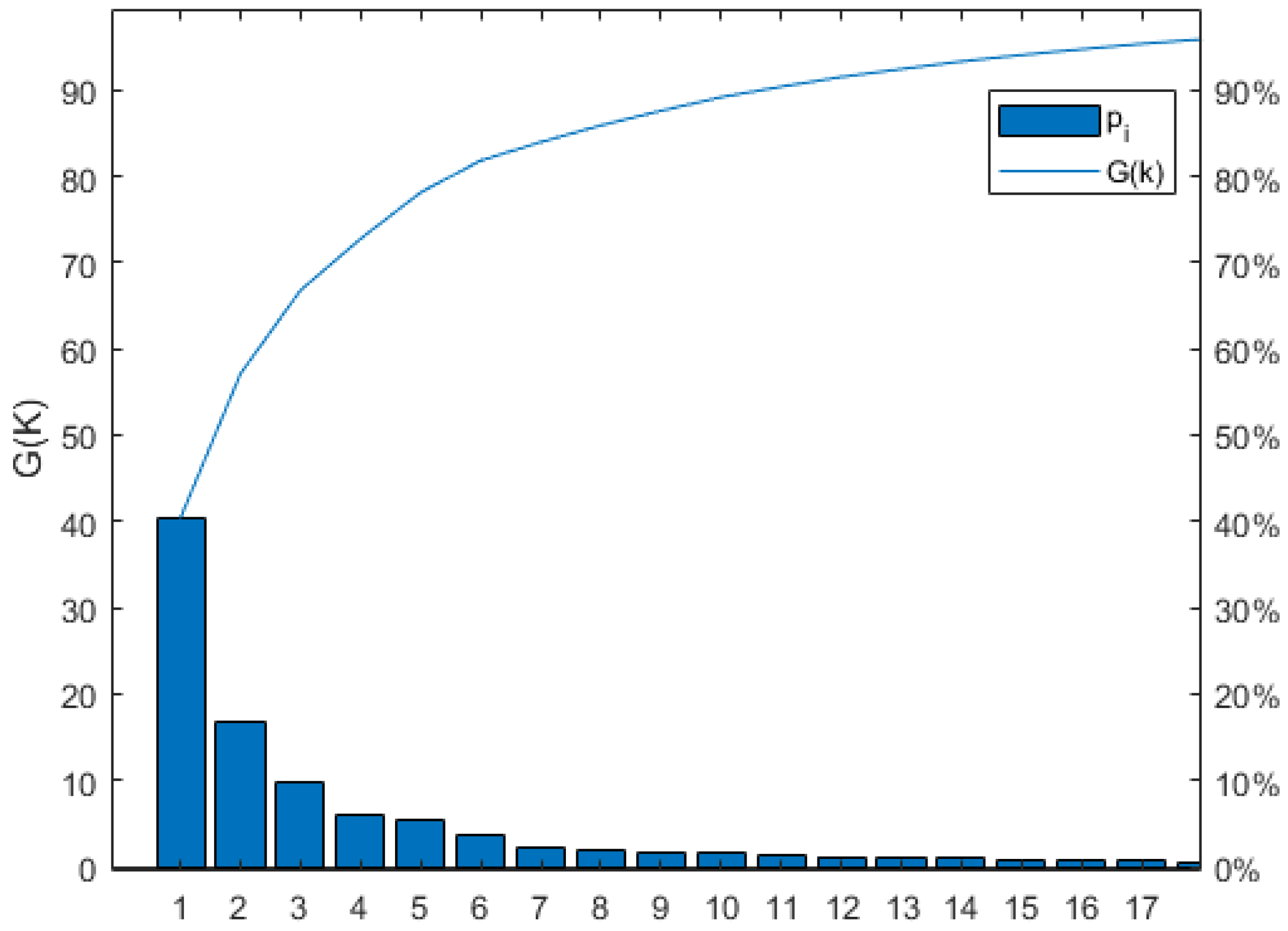
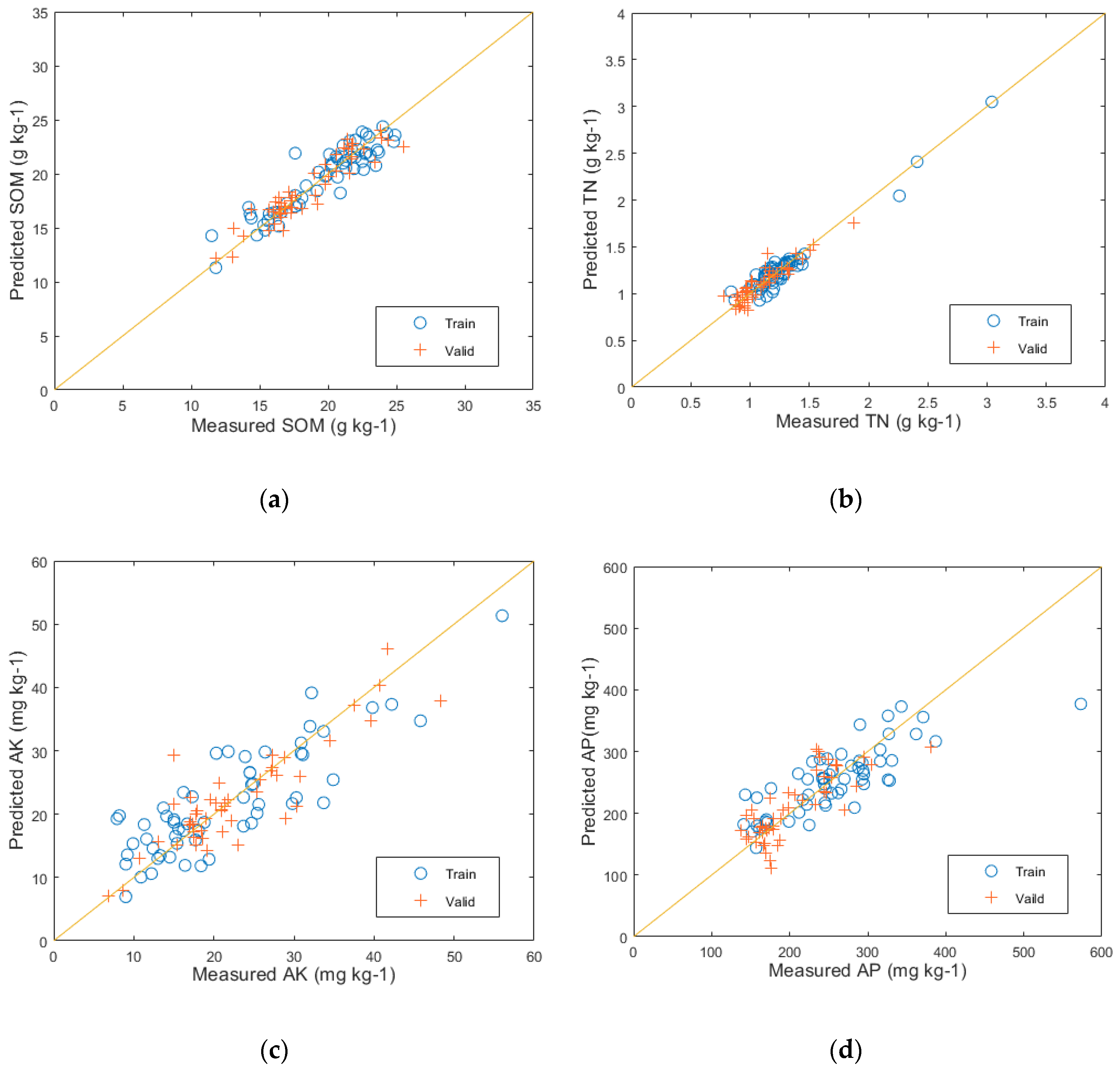
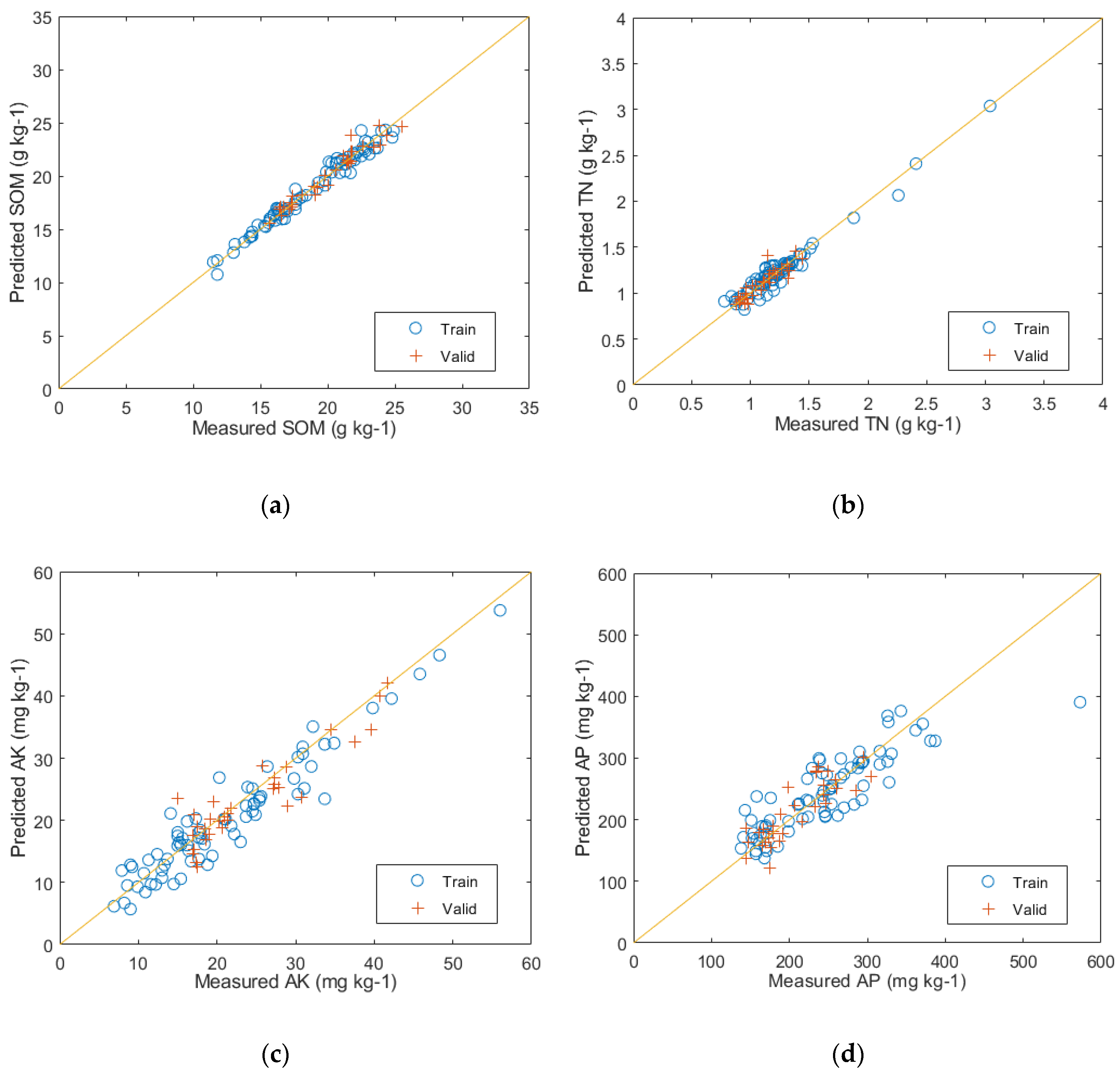
| Experimental Parameters | Conditional Values |
|---|---|
| Collection location | Jilin University |
| Collection time | 2022 |
| Cracking temperature | 400 °C |
| Cracking time | 3 min |
| Response time | 3 min |
| Response Features | Sensors | Feature Numbers |
|---|---|---|
| TV7S | S1, S2, S3……S9, S10 | T1, T2, T3, T4, T5, T6, T7, T8, T9, and T10 |
| MDCV | S1, S2, S3……S9, S10 | D1, D2, D3, D4, D5, D6, D7, D8, D9, and D10 |
| MAX | S1, S2, S3……S9, S10 | A1, A2, A3, A4, A5, A6, A7, A8, A9, and A10 |
| MEAN | S1, S2, S3……S9, S10 | E1, E2, E3, E4, E5, E6, E7, E8, E9, and E10 |
| RAV | S1, S2, S3……S9, S10 | R1, R2, R3, R4, R5, R6, R7, R8, R9, and R10 |
| RSMV | S1, S2, S3……S9, S10 | M1, M2, M3, M4, M5, M6, M7, M8, M9, and M10 |
| RCV | S1, S2, S3……S9, S10 | C1, C2, C3, C4, C5, C6, C7, C8, C9, and C10 |
| Experimental Parameters | Conditional Values |
|---|---|
| Shooting location | Jilin Agricultural University |
| Shooting time | 2023 |
| Image resolution | 1600 × 1300 |
| Supplementary light source | Sunlight |
| Shooting distance | 18 cm |
| Spectral Index Features | Feature Numbers |
|---|---|
| NDVI | Nmax, Nmin, Nmean, and Nstd |
| EVI | Emax, Emin, Emean, and Estd |
| NDRE | Dmax, Dmin, Dmean, and Dstd |
| RVI | Rmax, Rmin, Rmean, and Rstd |
| MSAVI | Smax, Smin, Smean, and Sstd |
| TVI | Tmax, Tmin, Tmean, and Tstd |
| BI2 | Bmax, Bmin, Bmean, and Bstd |
| Main Soil Nutrients | Feature Importance Ranking (r > 0.1) |
|---|---|
| SOM | R2, E2, M2, T3, T2, E3, R3, A2, D2, C2, M3, A3, Nmax, Tmax, C3, D3, Smax, Sstd, Dstd, T1, Dmax, Smean, Nmean, Tmean, M6, R6, E6, A6, T6, Emean, Bmax, M9, Bstd, T8, E10, R10, A9, M10, R9, E9, Bmean, T9, D9, Bmin, C9, A10, Rstd, E1, R1, T10, Emin, Rmean, A7, M1, Tmin, Dmean, Smin, Nmin, A1, C8, D8, M7, Rmin, E7, R7, E8, R8, A4, Rmax, T7, and T5 |
| TN | A5, R5, E5, M5, T5, C5, D5, Rmax, M1, M8, R1, E1, C7, D7, C8, D8, R8, E8, A1, A8, A7, M7, T9, E7, R7, T1, T10, C9, D9, R9, E9, T4, A9, E10, R10, A10, M10, D3, M9, C3, C1, D1, T8, T7, A4, A3, C10, A6, D10, M6, C6, D6, R6, E6, R4, E4, A2, M4, Nmin, Emin, Emean, Estd, M3, R2, E2, M2, T2, Dstd, T6, Dmean, Nstd, R3, E3, Nmean, D2, C2, Rstd, Nmax, and Tmax |
| AK | Bstd, T3, D4, C4, E3, R3, T9, D6, C6, M3, Tmean, M2, E2, R2, C2, D2, A2, T2, C3, D3, Nmean, A3, T1, Smean, Smax, Rstd, Tmax, Nmax, Nstd, D8, C8, Emin, C1, D1, T10, Dmax, Tstd, E1, R1, E4, R4, E9, R9, M4, Rmean, M1, E10, R10, T4, Dmin, C7, M10, D7, M9, D10, Sstd, and C10 |
| AP | R2, E2, A2, M2, A3, T2, M3, C2, D2, E3, R3, C3, D3, T3, A5, M5, E5, R5, D6, C6, C7, D7, D5, C5, T6, D8, C8, C4, A1, D4, D1, C1, M1, R6, E6, T5, Sstd, Emin, M6, Bmean, Bstd, M8, A7, M7, T9, Dmean, E1, R1, E7, R7, D10, Nstd, C10, Dstd, A6, A8, Tmin, Nmin, Rmin, Smax, Smin, Bmax, Tmax, Nmax, Emean, M4, Emax, and Rmax |
| Methods | Main Soil Nutrients | Optimal Number of Features | GA-BP |
|---|---|---|---|
| R2 | |||
| PCA | SOM | 17 | 0.8380 |
| TN | 0.7944 | ||
| AK | 0.6812 | ||
| AP | 0.5904 | ||
| PCC | SOM | 31 | 0.7592 |
| TN | 31 | 0.7356 | |
| AK | 17 | 0.5793 | |
| AP | 15 | 0.4792 |
| Authors | SOM | TN | AK | AP | References | ||||||||
|---|---|---|---|---|---|---|---|---|---|---|---|---|---|
| R2 | RMSE | RPD | R2 | RMSE | RPD | R2 | RMSE | RPD | R2 | RMSE | RPD | ||
| Xia | 0.90 | 5.98 | 2.85 | - | - | - | - | - | - | - | - | - | [46] |
| Li | - | - | - | 0.93 | 0.22 | 3.79 | - | - | - | - | - | - | [47] |
| Liu | - | - | - | - | - | - | 0.78 | 23.10 | 1.88 | 0.58 | 4.69 | 1.52 | [48] |
| Ours | 0.96 | 0.56 | 5.66 | 0.95 | 0.07 | 4.48 | 0.84 | 3.21 | 2.37 | 0.73 | 3.70 | 1.73 | - |
| Methods | SOM | TN | AK | AP | References | |||||
|---|---|---|---|---|---|---|---|---|---|---|
| R2 | RMSE | R2 | RMSE | R2 | RMSE | R2 | RMSE | |||
| Remote sensing | Zhou | - | - | 0.57 | 0.24 | - | - | - | - | [49] |
| Gasmi | 0.69 | 0.56 | - | - | 0.51 | 159.29 | 0.44 | 44.10 | [50] | |
| Spectroscopy | He | 0.91 | 0.08 | - | - | - | - | - | - | [51] |
| Wang | - | - | - | - | 0.49 | 22.80 | - | - | [52] | |
| Ours | 0.96 | 0.56 | 0.95 | 0.07 | 0.84 | 3.21 | 0.73 | 3.70 | - | |
Disclaimer/Publisher’s Note: The statements, opinions and data contained in all publications are solely those of the individual author(s) and contributor(s) and not of MDPI and/or the editor(s). MDPI and/or the editor(s) disclaim responsibility for any injury to people or property resulting from any ideas, methods, instructions or products referred to in the content. |
© 2024 by the authors. Licensee MDPI, Basel, Switzerland. This article is an open access article distributed under the terms and conditions of the Creative Commons Attribution (CC BY) license (https://creativecommons.org/licenses/by/4.0/).
Share and Cite
Fu, L.; Liu, S.; Huang, D.; Wang, J.; Jiang, X.; Wang, G. Utilizing the Fusion Characteristics of Multispectral and Electronic Noses to Detect Soil Main Nutrient Content. Agriculture 2024, 14, 605. https://doi.org/10.3390/agriculture14040605
Fu L, Liu S, Huang D, Wang J, Jiang X, Wang G. Utilizing the Fusion Characteristics of Multispectral and Electronic Noses to Detect Soil Main Nutrient Content. Agriculture. 2024; 14(4):605. https://doi.org/10.3390/agriculture14040605
Chicago/Turabian StyleFu, Lili, Shuyan Liu, Dongyan Huang, Jingli Wang, Xinming Jiang, and Gang Wang. 2024. "Utilizing the Fusion Characteristics of Multispectral and Electronic Noses to Detect Soil Main Nutrient Content" Agriculture 14, no. 4: 605. https://doi.org/10.3390/agriculture14040605





